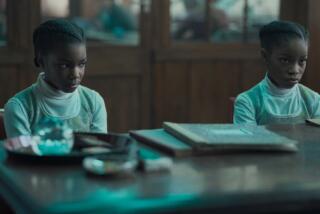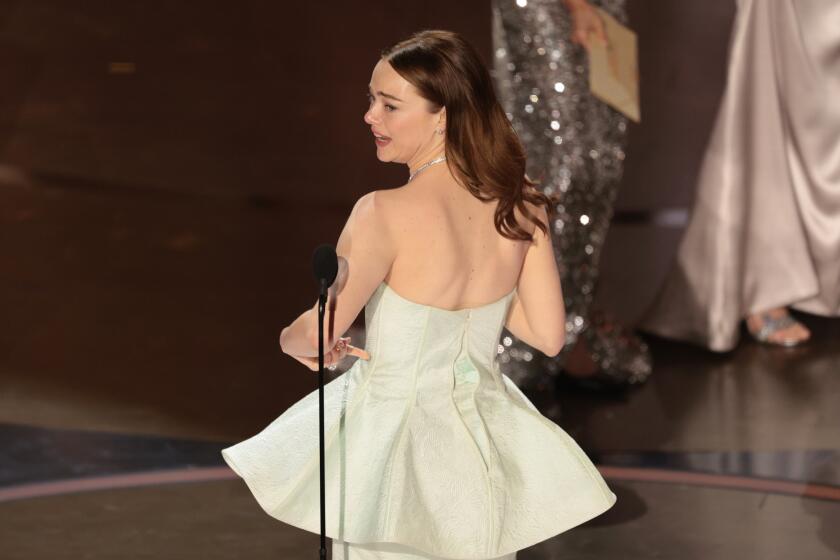A Feather in Ballard’s Cap
There was something missing when director Carroll Ballard arrived on location in southern Ontario to film “Fly Away Home.” In place were the cast--including soon-to-be-hatched goose eggs--and the rights to a television documentary about a Canadian who taught geese how to fly. All Ballard lacked was a script.
Still, script or no script, Ballard knew he had to start shooting quickly, since the eggs were due to hatch any minute. Luckily, the director is no stranger to directing animals, with “The Black Stallion” and “Never Cry Wolf” under his belt.
First the unhatched flock had to be imprinted with co-star Anna Paquin’s voice calling to them, so when hatched they would already be attached to her. “They can hear all kinds of things inside their eggs,” Ballard explains, “so we played a recording of Anna’s voice saying: ‘Hey, goose, goose, goose,’ so they’d get used to her.”
Next came the actual hatching. “When we shot the little guys coming out of their shells,” Ballard says, “we had no idea what the rest of the movie was going to be like.” And once the geese emerged, time became even more crucial as their appearance began to change almost by the hour.
“In about three hours after they hatch,” Ballard says, “they begin to fluff up, and they grow and change color so quickly that by the age of 3 weeks they’re already a goose walking around and flapping their wings.” With Paquin on the set, Ballard began shooting scenes of the actress playing with the goslings until Columbia, the studio producing the movie, finally had a script it was happy with.
‘Fly Away Home,” which opens Friday, is based on the experiences of Toronto-based artist Bill Lishman, who with his partner Joe Duff raised a flock of geese and guided it in 1993 along a migration route by flying alongside
the wildfowl in an ultralight aircraft. “We stole a lot of stuff that Bill actually did and pasted them together as a story,” Ballard says. To give a dramatic context to Lishman’s adventures, the fictional characters of a father and daughter, played by Jeff Daniels and Paquin, were added.
Ballard admits he hesitated when offered the opportunity to direct the film. “It was obvious that the studio just wanted to make a children’s movie, or else. They had no concept of what the movie was going to be about.”
But Ballard, who says he doesn’t like to make “high body count or explosion movies,” is pleased with the final product. “I’m happy with it--it’s not namby-pamby or cutesy,” he says. “I think we managed to avoid that to some degree.”
In the film, Paquin plays a 13-year-old girl living on an Ontario farm who adopts an orphaned nest of goose eggs. Once hatched, the geese believe Paquin is their mother, following her everywhere she goes. But eventually the geese mature and must migrate south for the fall. Without a mother goose to teach them, the young geese not only need to learn to fly, they also need to learn their way toward a safe and warm haven. With the help of her father, who builds two planes to lead the geese to a refuge in South Carolina, the teenager takes to the air, with the geese flying in her wake.
Needless to say, the film called for a lot of aerial shots, mostly accomplished by a second unit team headed by Gary Capo, for whom Ballard has endless amounts of praise--because working with the geese posed a set of dilemmas. For instance, a special aircraft had to be designed that was sturdy enough to carry a feature film camera, but also able to fly at “Mach goose” (i.e., very slowly) without falling out of the sky.
But even designing an airplane is relatively simple when compared to controlling the force of nature. “Several times during the shooting,” Ballard says, “the wind would get really strong and blow the geese across the lake somewhere and there’d be no way of knowing where they all went. That made shooting a little scary.”
Despite the tight 12-week shooting schedule and the innate eccentricity of working with birds, Ballard was able to concentrate on building compelling images.
“I’m an eyeball guy,” he explains, “I’m not much of a word guy, so there are a lot of visual metaphors in the film that weren’t in the script.” Fortunately, Ballard found himself reteamed with director of photography Caleb Deschanel, who previously had shot a few of Ballard’s early documentaries as well as his first feature, “The Black Stallion.”
“Cinematographers and I usually get along quite well,” says Ballard, who earned his stripes as a second unit director on “Star Wars” and several Francis Ford Coppola films, including “The Godfather.” “Sometimes I make their lives a lot worse because I have strong opinions about certain kinds of gear and certain kinds of lights.”
“Carroll knows how to tell stories visually,” Deschanel says. “You don’t have to explain a lot of things like you do with other directors. But that can also be a drawback because you can’t get away with the same things.”
As far as working with geese, Deschanel says it’s not that different from working with humans. “They have a community personality that you can eventually learn and understand,” he says, but he admits that “they’re much less trainable than horses or dogs, so there are aspects that are frustrating. There were definitely times that they weren’t cooperative.”
For Ballard’s part, he says he came away from filming “Fly Away Home” with an admiration for the geese. “When you think about how far these geese travel,” he says, “when you think of the enormous amount of territory that they fly over in totally different times of the year, it’s amazing how they all make it back. How the hell do they do that?”
More to Read
Only good movies
Get the Indie Focus newsletter, Mark Olsen's weekly guide to the world of cinema.
You may occasionally receive promotional content from the Los Angeles Times.






